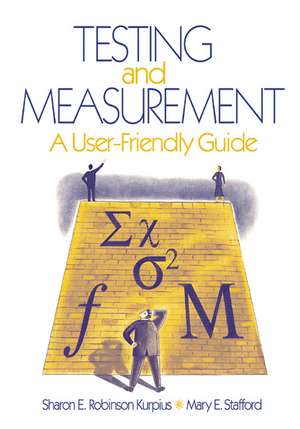Testing and Measurement: A User-Friendly Guide
Autor Sharon E. Robinson Kurpius, Mary E. Stafforden Limba Engleză Paperback – 19 oct 2005
Preț: 553.49 lei
Preț vechi: 651.16 lei
-15% Nou
Puncte Express: 830
Preț estimativ în valută:
105.91€ • 110.58$ • 87.65£
105.91€ • 110.58$ • 87.65£
Carte tipărită la comandă
Livrare economică 05-19 aprilie
Preluare comenzi: 021 569.72.76
Specificații
ISBN-13: 9781412910026
ISBN-10: 1412910021
Pagini: 200
Dimensiuni: 178 x 254 x 11 mm
Greutate: 0.35 kg
Ediția:1
Editura: SAGE Publications
Colecția Sage Publications, Inc
Locul publicării:Thousand Oaks, United States
ISBN-10: 1412910021
Pagini: 200
Dimensiuni: 178 x 254 x 11 mm
Greutate: 0.35 kg
Ediția:1
Editura: SAGE Publications
Colecția Sage Publications, Inc
Locul publicării:Thousand Oaks, United States
Cuprins
List of Figures
List of Tables
A Note to Students
Acknowledgments
1. What Is a Number? Is a Rose Always a Rose?
Numbers and Scales
Some Final Thoughts About Scales of Measurement
Numbers and Response Formats
Some Final Thoughts About Response Formats
Numbers and Test Scores--How Do They Relate?
Some Final Thoughts About Measurement Scales and Response Formats
Key Terms
Models and Self-instructional Exercises
Words of Encouragement
2. Frequencies: One Potato, Two Potato, Three Potato, Four
Ungrouped Frequency Distributions
Grouped Frequency Distributions
Cumulative Frequency Distribution
Some Final Thoughts About Frequency Distributions
Key Terms
Models and Self-instructional Exercises
Words of Encouragement
3. The Distribution of Test Scores--The Perfect Body?
Kurtosis
Skewness
Some Final Thoughts About Distribution of Test Scores
Key Terms
Models and Self-instructional Exercises
Words of Encouragement
4. Central Tendencies and Dispersion--Coming Together or Growing Apart
Central Tendencies--The Inner Core of the Normal Curve
The Mode
The Median
Medians and Modes for Grouped Frequency Data
The Mean
Some Final Points About Central Tendency
Dispersion--Not All Bodies Are the Same
Range
Deviation Scores
Variance
Standard Deviation
Means and Standard Deviations in the Real World
Key Terms
Models and Self-instructional Exercises
Your New Best Friend--SPSS
Words of Encouragement
5. Standardized Scores--Do You Measure Up?
Percentiles--What They Mean in Measurement
Percentile Ranks for Grouped Data
Some Final Thoughts About Percentile Ranks
Z Scores
Why Transform a Raw Score to a Z Score?
Other Standard Scores
Key Terms
Models and Self-instructional Exercises
Your New Best Friend–SPSS
Words of Encouragement
6. Norms and Criterion Scores--Keeping Up With the Joneses or Not
Criterion-Referenced Tests--Do You Know as Much as You Should?
Norm-Referenced Tests--Dying to Fit In
Key Terms
Models and Self-instructional Exercises
Words of Encouragement
7. Error Scores--The Truth, the Whole Truth, and Nothing but the Truth?
Test Theory
Test-Theory Assumptions
Key Terms
Models and Self-instructional Exercises
Words of Encouragement
8. Building a Strong Test--One the Big Bad Wolf Can’t Blow Down
Item Difficulty
Some Final Thoughts About Item Difficulty
Item Discrimination
Key Terms
Models and Self-instructional Exercises
Words of Encouragement
9. Reliability--The Same Yesterday, Today, and Tomorrow
The Mathematical Foundation of Reliability
Types of Reliability Estimates
Standard Error of Measurement
Correlation Coefficients as Measures of Reliability
Some Final Thoughts About Reliability
Key Terms
Models and Self-instructional Exercises
Words of Encouragement
10. Validity--What You See Is Not Always What You Get
Helping You Get What You See
Sources of Validity Evidence
The Marriage of Reliability and Validity--Wedded Bliss
Interpreting the Validity of Tests--Intended and Unintended Consequences
Some Final Thoughts About Validity
Key Terms
Models and Self-instructional Exercises
Words of Encouragement
11. The Perils and Pitfalls of Testing--Being Ethical
Your Own Competence
Rights of Those Being Tested
Potential Dangers
Ryan's Rights
Appendix
References
Index
About the Authors
List of Tables
A Note to Students
Acknowledgments
1. What Is a Number? Is a Rose Always a Rose?
Numbers and Scales
Some Final Thoughts About Scales of Measurement
Numbers and Response Formats
Some Final Thoughts About Response Formats
Numbers and Test Scores--How Do They Relate?
Some Final Thoughts About Measurement Scales and Response Formats
Key Terms
Models and Self-instructional Exercises
Words of Encouragement
2. Frequencies: One Potato, Two Potato, Three Potato, Four
Ungrouped Frequency Distributions
Grouped Frequency Distributions
Cumulative Frequency Distribution
Some Final Thoughts About Frequency Distributions
Key Terms
Models and Self-instructional Exercises
Words of Encouragement
3. The Distribution of Test Scores--The Perfect Body?
Kurtosis
Skewness
Some Final Thoughts About Distribution of Test Scores
Key Terms
Models and Self-instructional Exercises
Words of Encouragement
4. Central Tendencies and Dispersion--Coming Together or Growing Apart
Central Tendencies--The Inner Core of the Normal Curve
The Mode
The Median
Medians and Modes for Grouped Frequency Data
The Mean
Some Final Points About Central Tendency
Dispersion--Not All Bodies Are the Same
Range
Deviation Scores
Variance
Standard Deviation
Means and Standard Deviations in the Real World
Key Terms
Models and Self-instructional Exercises
Your New Best Friend--SPSS
Words of Encouragement
5. Standardized Scores--Do You Measure Up?
Percentiles--What They Mean in Measurement
Percentile Ranks for Grouped Data
Some Final Thoughts About Percentile Ranks
Z Scores
Why Transform a Raw Score to a Z Score?
Other Standard Scores
Key Terms
Models and Self-instructional Exercises
Your New Best Friend–SPSS
Words of Encouragement
6. Norms and Criterion Scores--Keeping Up With the Joneses or Not
Criterion-Referenced Tests--Do You Know as Much as You Should?
Norm-Referenced Tests--Dying to Fit In
Key Terms
Models and Self-instructional Exercises
Words of Encouragement
7. Error Scores--The Truth, the Whole Truth, and Nothing but the Truth?
Test Theory
Test-Theory Assumptions
Key Terms
Models and Self-instructional Exercises
Words of Encouragement
8. Building a Strong Test--One the Big Bad Wolf Can’t Blow Down
Item Difficulty
Some Final Thoughts About Item Difficulty
Item Discrimination
Key Terms
Models and Self-instructional Exercises
Words of Encouragement
9. Reliability--The Same Yesterday, Today, and Tomorrow
The Mathematical Foundation of Reliability
Types of Reliability Estimates
Standard Error of Measurement
Correlation Coefficients as Measures of Reliability
Some Final Thoughts About Reliability
Key Terms
Models and Self-instructional Exercises
Words of Encouragement
10. Validity--What You See Is Not Always What You Get
Helping You Get What You See
Sources of Validity Evidence
The Marriage of Reliability and Validity--Wedded Bliss
Interpreting the Validity of Tests--Intended and Unintended Consequences
Some Final Thoughts About Validity
Key Terms
Models and Self-instructional Exercises
Words of Encouragement
11. The Perils and Pitfalls of Testing--Being Ethical
Your Own Competence
Rights of Those Being Tested
Potential Dangers
Ryan's Rights
Appendix
References
Index
About the Authors
Notă biografică
Since I was a small child, I have always been a nurturer, someone who helps others. I patiently listen to their concerns, let them express their feelings, and, when appropriate, help them look at ways to feel better or behave differently. In its simplest form, I think of mentoring as a process of nurturing others. For me, it is using who I am and what I know to foster the personal and professional growth of graduate students. This is what I find most fulfilling about being a professor-the opportunity to develop meaningful individual relationships with my students with the primary goal being their academic and career success and fulfillment.
As I reflected on my almost 29-year tenure as a faculty member at Arizona State University, I realized that I have had the privilege of fostering the development of 50 doctoral graduates, as well as numerous master degree graduates. Currently, I am directing the dissertations of nine students. The students who enter our doctoral program in counseling psychology are amazing. They are unbelievably bright, articulate, and curious, and invariably kind-hearted. To be able to work with them is a privilege. I have never viewed being a teacher and mentor as a task or as "a job." Instead, I believe that these students have been gifts to me. As I have tried to enrich their lives and careers, they have enriched mine both personally and professionally. Mentoring is a reciprocal process, occurring in stages.
As I reflected on my almost 29-year tenure as a faculty member at Arizona State University, I realized that I have had the privilege of fostering the development of 50 doctoral graduates, as well as numerous master degree graduates. Currently, I am directing the dissertations of nine students. The students who enter our doctoral program in counseling psychology are amazing. They are unbelievably bright, articulate, and curious, and invariably kind-hearted. To be able to work with them is a privilege. I have never viewed being a teacher and mentor as a task or as "a job." Instead, I believe that these students have been gifts to me. As I have tried to enrich their lives and careers, they have enriched mine both personally and professionally. Mentoring is a reciprocal process, occurring in stages.
Descriere
Written with Bandura's social learning theory in mind, Testing and Measurement: A User-Friendly Guide allows students to master testing and measurement through a three-stage learning process - presentation of information, modeling, and practice with direct feedback. Authors Sharon E. Robinson Kurpius and Mary E. Stafford take students through the essential components of measurement, starting with measurement scales and ending with reliability and validity. Taking the attitude that everyone can learn testing and measurement concepts, the authors make this learning process fun and non-threatening.








